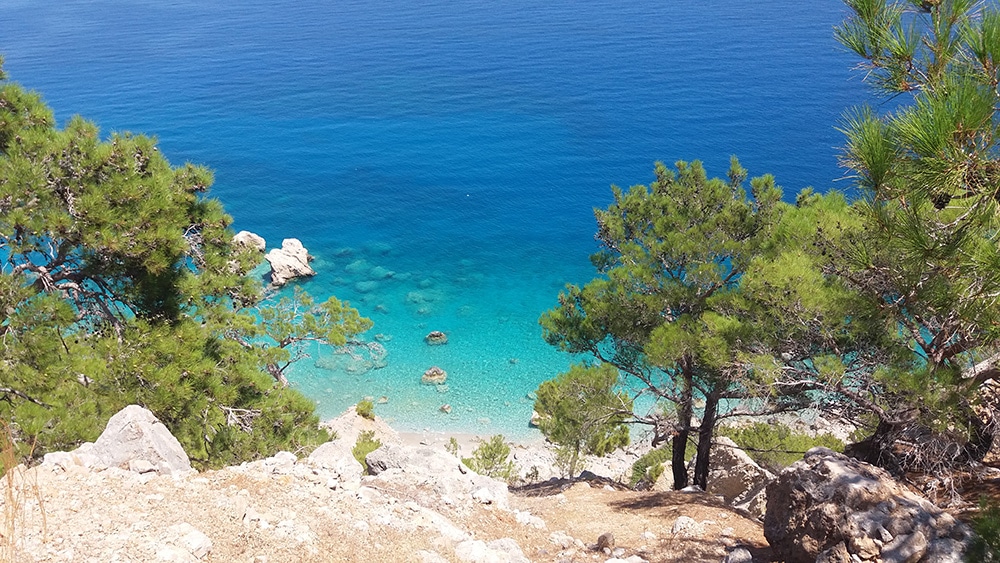Karpathos, the Greece you don’t expect, emerges proud and majestic from the waters of the Aegean, nestled between the better-known Rhodes and Crete. With its rough peaks plunging into a Caribbean-hued sea, it seems to have been chosen by Mother Nature to do technical tests in painting and sculpture. I find myself traversing it from top to bottom, alone, enchanted by the thousands of landscape diversities that cohabit in just 50 kilometers in length, a riot of colors that make even the rainbow embarrassed. I depart from the center in a northerly direction driving through a moonscape that unexpectedly opens into a wide, lush, rocky valley that connects ancient Avlona with lonely Tristomo, an enchanted bay of emerald colors. From here it is possible to reach the uninhabited island of Saria, a refuge for the Mediterranean monk seal, characterized by blinding white rocks bordering the paths before breaking into crystal-clear water. The North is to be experienced by walking, between sheer mule tracks and isolated beaches with the silvery hues that the gray pebbles mixed with gravel give them. It is in this continuous up and down of ash-colored mountains that Olympos, the ancient capital, is hidden. They will tell you that time has stood still here, but as you wander through the narrow streets filled with stores selling quality local handicrafts, you breathe in the liveliness and lightheartedness of the locals who, inside their traditional clothes, bestow smiles and proudly display the red, orange and blue hues of hand-stitched fabrics. I stop to eat at a tavern to taste makarounes, typical homemade pasta topped with a sauce of onion, butter, oil and a sprinkling of goat cheese. Seasoning and specific weight of the dough dictate a digestive nap but I have no time and continue my adventure. As I descend eastward, between the village of Spoa and the capital Pigadia, it is a continuous succession of breathtaking views where the acid green of the Mediterranean pines mingles with the turquoise of the sea that bathes the island’s best-known beaches. I push further south to learn about the much, rightly, vaunted Amoopi beach and look out to see what the lookout in front of which I parked is hiding. My breath stops, my heart quickens its beat, it is love at first sight. Votsalakia Beach, seductive and wild, is the place on planet earth that Mother Nature has chosen as an artistic laboratory, alternating brush and chisel, throwing stones into the water, preserving the rough, jagged rock by sheltering it from the winds. The sun’s rays come to her rescue, seeming to play hide-and-seek among the rocks, leaving blinding glares here and there and making headlong in between the natural arches that provide breathtaking glimpses. The crystal-clear water joins the party and enjoys changing colors, alternating between emerald green and turquoise hues amid the bustle of phlegmatic waves bathing the dark pebble beach. I feel like waiting for the sun to set on the horizon, but this is home to the island’s most beautiful sunrises in shades of orange and brown. For sunsets I have to pass through inland villages, leaning here and there on the mountain range that divides east from west and where Kali Limni, the highest peak in the Dodecanese, rises.
Jumping from one village to another, I store up unforgettable images given by the views accessed by the golden yellow of a sun that seems to want to lodge here all day long. In front of this natural spectacle, a break is a must. I sit down at a tavern with a view to chat with local elders, historical memory of the island, who attempt to speak in my language in remembrance of the time when Karpathos was under Italian rule. I resume my journey greeting them with gratitude for that precious exchange that smacks of youth and nostalgia. As I descend westward, a completely different scenery appears to me: the green gives way to the celestial hues of the picturesque coves of Lekfos, to the deep blue of the overpowering glimpses offered by the road that runs overhanging the sea, and to the orange and purple hues of Arkasa, cradle of the most striking sunsets in the Mediterranean where the blazing sun seems to want to dive into the water to cool off. Arkasa welcomed, hosted and pampered me but that is not why it will always remain in my heart. Here the meltemi blows overbearingly as if to dust the mind of thoughts, the crystal clear water looks like diamond and life flows lightly away from the din of mass tourism that has failed to colonize and distort it. Orange and purple hues mingle with the color of the earth as I proceed south, the least inhabited and most authentic area of the entire island, where the trekking walks are tinged with bottle green and have the scent of thyme that grows wild throughout the area. Accompanied by the little goats walking undisturbed between pastures and paved road, I wander in search of the island’s most beautiful beaches. I enchant myself in front of the expanse of sand at Diakoftis, the addictive African-colored beach, take a mud bath at the emerald beach of Agios Theodoros, but Michaliou Kipos wins me over with a thousand shells set in white stone, desert hues, and a thatched and wooden tavern where I stop to sip an ice-cold beer. My journey ends here; with my gaze lost in the horizon, I cross with my mind the infinite range of colors that accompanied me along the entire journey. At every turn, Karpathos gave me new emotions, each beach I fell more in love with than the one before, and on each peak I felt as if the wind was in my veins. Of Karpathos there is only one…if you don’t know it it will seduce you at the first meeting, if you know it you are already hopelessly in love. *** If you are planning your trip to Greece and want to discover the extraordinary natural beauty of Karpathos, check out our programs Hiking in Karpathos and On the Way to the Blue



